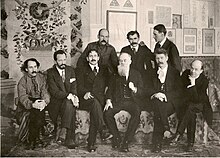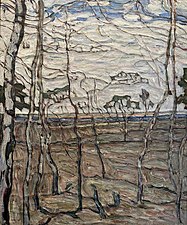Abraham A. Manievich
- Machine translation, like DeepL or Google Translate, is a useful starting point for translations, but translators must revise errors as necessary and confirm that the translation is accurate, rather than simply copy-pasting machine-translated text into the English Wikipedia.
- Do not translate text that appears unreliable or low-quality. If possible, verify the text with references provided in the foreign-language article.
- You must provide copyright attribution in the edit summary accompanying your translation by providing an interlanguage link to the source of your translation. A model attribution edit summary is
Content in this edit is translated from the existing Belarusian Wikipedia article at [[:be:Абрам Аншэлавіч Маневіч]]; see its history for attribution. - You may also add the template
{{Translated|be|Абрам Аншэлавіч Маневіч}}to the talk page. - For more guidance, see Wikipedia:Translation.


Abraham Anshelovich Manievich[a] (Ukrainian: Абрам Аншелович Маневич, romanized: Abram Anshylovych Manevych; 25 November 1881 Mstsislaw, Belarus – 30 June 1942 Bronx, United States) was a Ukrainian-American expressionist artist of Belarusian-Jewish origin.[1][2]
Life
He studied art at the Kyiv Art School from 1901 to 1905, and at the Academy of Art in Munich, Germany.[3] After travelling and successfully exhibiting in Italy, France, and Switzerland[4] as well as Kiev, he lived in Moscow from 1916 to 1917.

A co-founder of the Ukrainian Academy of Arts,[5] he taught at the Ukrainian Academy of Fine Arts. In 1921, following the death of his son in the pogrom-initiated destruction of the Kiev ghetto,[6] he emigrated to the United States.[7] His continued work enjoyed critical acclaim until his death.[6]
His work is in the National Art Museum of Ukraine and in major museums and private collections in the United States, Canada, France, Israel, Russia, and Ukraine.[7] His papers are held at the Archives of American Art.[8]
Gallery
-

-

-

-

-
 Birch Trees (ca. 1911)
Birch Trees (ca. 1911)
Notes
- ^ Also Abram Manevich
Further reading
- Abraham Manievich by Alan Pensler and Mimi Ginsberg, New York: Hudson Hills ; Woodbridge : ACC Distribution [distributor], 2012.*[1]
- Jbankova, O (2003). Абрам Маневич [Abram Manevich] (PDF). Kiev. ISBN 966-7888-48-7.
{{cite book}}: CS1 maint: location missing publisher (link)
References
- ^ "Art: Queer Manievich". Time. February 14, 1927.
- ^ "Abraham Manievich - 52 artworks - painting".
- ^ "Abraham Manievich, Prominent Jewish Painter, Dies in New York". Jewish Telegraphic Agency. July 1, 1942.
- ^ "ecatalogue 2012". Sotheby's.
- ^ File:Founders of the Ukrainian academy of arts.jpg
- ^ a b "The Jewish Museum".
- ^ a b "Abram Manevich on Zorya Fine Art". www.zoryafineart.com. Retrieved December 14, 2022.
- ^ "Abraham Manievich papers, 1883-1973, bulk 1883-1942 | Archives of American Art, Smithsonian Institution". www.aaa.si.edu. Retrieved December 14, 2022.
External links
- Abraham Manievich - Biography
- Abraham Manievich (1881/83-1942)
- Abraham Manievich past auction
















